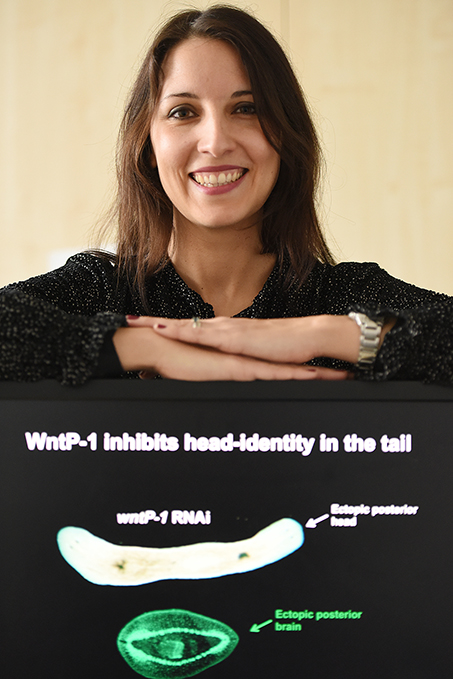“I’m proud to be a good mother and researcher”

Dr. Bartscherer, what scientific topic are you working on right now?
I’m doing research on flatworms, which are almost indestructible because they can completely regenerate every part of their body. If you cut them up into pieces, the parts of the body missing then grow again on each of the pieces – and in the end you have several complete worms. This ability is pretty exciting for biomedical questions, because we humans have very limited regenerative abilities – an amputated arm, for example, remains truncated. My research group and I want to know why it’s different with flatworms. In particular, we look at the wound signals and stem cells in these animals after a cut and ask ourselves, for example, how the stem cells learn that they have to move towards the wound. What decides what kind of cell they develop into?
What characterizes you personally as a scientist?
I have two children, three and six years old. The elder daughter was born just after I finished my PhD in Heidelberg. That was a good time for me and I got a lot of support from my boss at the time, Prof. Michael Boutros. The younger daughter was born in Münster, when I had already been doing independent research. I’m proud to be a good mother and researcher and I’m happy to be a role model for younger women scientists who have difficulties in making decisions about their future. The important thing is to accept as much help as possible. Everyone has to lend a hand: the husband, the au-pair and the cleaning lady.
What is your great aim as a scientist?
I’d like to understand in detail the chain of molecular and cellular events that take place during regeneration. All the research projects in the lab are directed towards this. What’s important to me in this is a positive working atmosphere – one characterized by cooperation, teamwork, mutual respect and motivation. I see my job, as team leader, in creating and maintaining this atmosphere.
What’s your favourite “toy” for research – and what can it do?
I haven’t worked in the lab for a long time now. I probably spend most of my time at the computer, looking at and evaluating the latest data generated by my team.
Can you remember your happiest moment as a scientist?
That was my first major paper, which I submitted in the third year of doing my PhD. I was just about to give a scientific talk about my work, and was already standing at the speaker’s lectern, when my PhD supervisor came in, slightly late, and showed me the good news on his smartphone: the paper was accepted for publication. That was an incredible feeling, because I then knew that all the hard work had been worthwhile. It really gave a boost to my talk. The next great moment was when I got the job at the MPI. This meant to finally be able to do independent research.
Which scientific phenomenon still regularly fascinates you today?
I find anything to do with astronomy fascinating. I’m stunned by the size of the universe and research into its origins impresses me. Unfortunately, I hardly have time to go into this in more detail.

